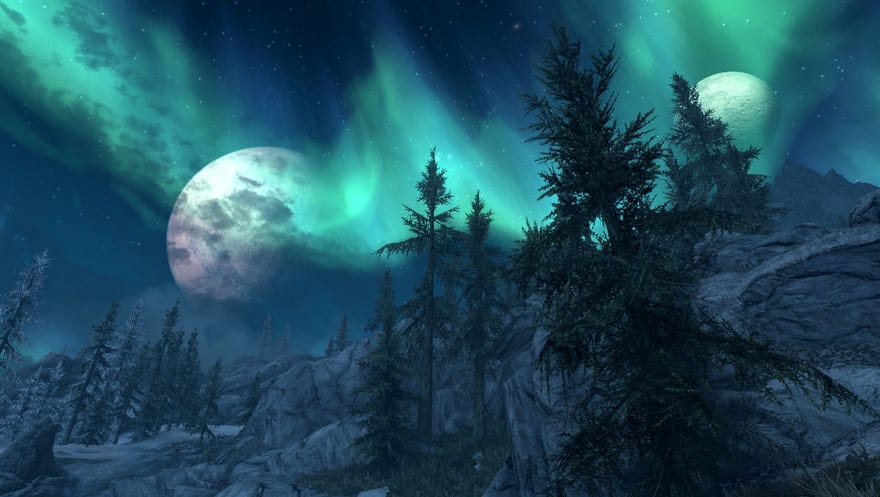Starfield's "are planets planets" debate recalls the amazingly weird cosmology of Elder Scrolls
Plane or planet?
You may have noticed a mounting squabble between Starfield fans and detractors concerning the game's planetary maps, triggered by some leaks or fake leaks over the past week. Said skirmish has now escalated to "-gate" status, with "Tilegate" doing the rounds on forums and even creeping into search results, presumably much to the alarm of innocent, unaligned ceramics company Tilegate Trading Llc in Florida. The nub of the dispute seems to be thus: some people claim the procedurally generated tiles that comprise many Starfield environments actually glue together into complete globes, so that you can see and walk from one to the other and, indeed, all around the equator, while others claim they're discrete maps with invisible walls, similar to those of the astonishing "dreamable" space sim Noctis.
Who knows, we might have an under-embargo Starfield review in the works that will lay matters to rest. In the short term, the uncertainty about whether Starfield's planets are actually planets puts me in mind of comparable celestial angst in Bethesda's Elder Scrolls games, where planets are more properly described as planes of existence, conjured by immortal beings, which sort of orbit the mortal world of Tamriel. I've been revisiting how Bethesda's mainstay fantasy games thought about outer space in the run-up to Starfield, and while I'm intrigued by the new game's portrayals of celestial mechanics (latest discovery: the Starfield starmap represents stellar and planetary gravity as dimples on a kind of galactic tarpaulin, as in old Stephen Hawking documentaries), I'll be very surprised if it offers anything quite as wonderfully bizarre.
Here, let me shrug on my stolen boffin's labcoat and try to give you an overview. Starfield seems to portray space according to a classical Newtonian understanding of astrophysics, give or take a few dollops of outright wizardry, with neatly distinguished celestial bodies forming solar systems that resemble glowing beads on wire hoops. For all Bethesda's talk of "punking" NASA, it's quite an everyday and well-travelled representation of outer space that already risks being conflated with a billion competing simulators on Steam (a quick shout-out here for one of my personal favourites, the submarine-adjacent Objects in Space).
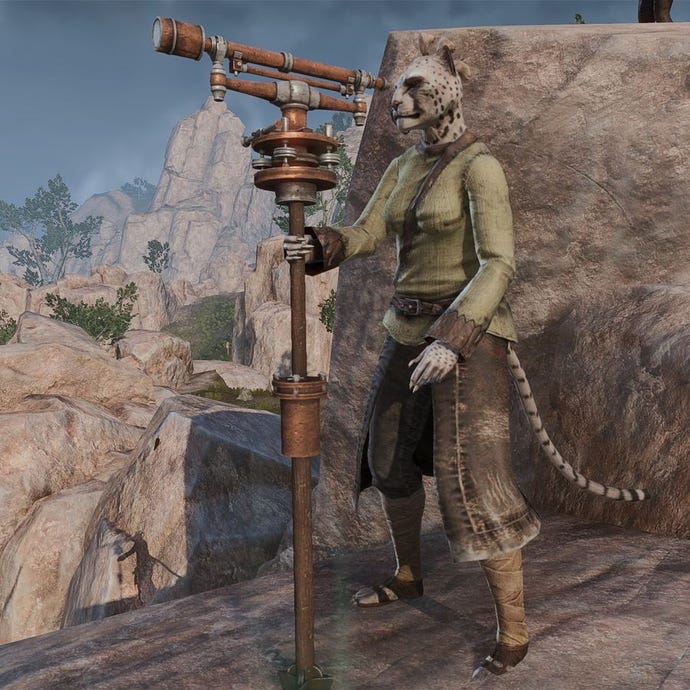
"Outer space" in the Elder Scrolls universe is... well, who knows, frankly. It straddles a faultline between contemporary science, astrology and geocentric cosmological models from before the days of Copernicus, while pinching esoteric ideas from all over.
Look up while foraging for nirnroots in Skyrim, and you might think you're gazing into another terrestrial night sky, albeit with too many moons. According to the game's lore, however, what you're actually looking at is a delusion born of your puny brain's inability to comprehend Oblivion, the voidish realm of the devilish Daedra, which surrounds the mortal plane of Mundus. Those moons? They're perpetually dying celestial spirits, their skin flaking away in the course of a lunar cycle that is actually a process of decomposition. Those stars? They're tears in the outer fabric of Oblivion that spill radiance from the magical realm of Aetherius. The largest of those holes is, of course, the sun - it marks the place where the creator god Magnus fled Mundus after wearying of his own handiwork.
I'm using terms like "outer fabric" and "place" here, but you can't really map the Elder Scrolls cosmology as you can Starfield's starfield. Mundus isn't really an area or volume, but the intersection between competing vital forces - a "Grey Maybe", to quote Bethesda's own Pocket Guide to the Empire, 3rd Edition, formed by the struggle between "wealth and subjugation, love and loss, life and death and undeath, inviolate laws of nature, and conversely, magickal means of breaking those laws".
I can already feel the Elder Scholars of Reddit smacking my typing fingers with a ruler, creaking in my ear that I'm making a hash of the details here. My respectful retort to these wizened theorycrafters is that confusion and debate about the precise nature of an Elder Scrolls night sky is part of each game's allure. As Morrowind's lead designer Ken Rolston wrote in 2012, this is the kind of thing that makes your fantasy world feel properly worldly, and brings your fanbase to a profitable simmer: "your setting should always be filled with franchise mysteries. And people in the setting should constantly argue about the Truths of those mysteries."
Each Elder Scrolls game is stuffed with NPC-written theories about the workings of Mundus, Oblivion and Aetherius that are fascinating to hoard and pick over (the court here duly notes and affirms the historic crimes of one Alice Bell, so-called deputy editor of this parish, who "accidentally" threw away my entire in-game Skyrim book collection while interning for Official Xbox Magazine). Ideas about the universe vary by the race or civilization: people from Cyrodiil reckon the planets are gods and also, the homes of the gods, while the feline Khajiit think they're a litter of kittens. Much of this chaos can be traced to the series' original scribes, especially the legendary Michael Kirkbride, who wrote a lot of Elder Scrolls backstory from the inside. Books aside, the Elder Scrolls series has a passion for orreries, aka mechanical solar system models - you'll find them in Redguard, Oblivion, Elder Scrolls Online and even free-to-play CCG Elder Scrolls: Legends. This is a setting that's as curious about itself as you are.

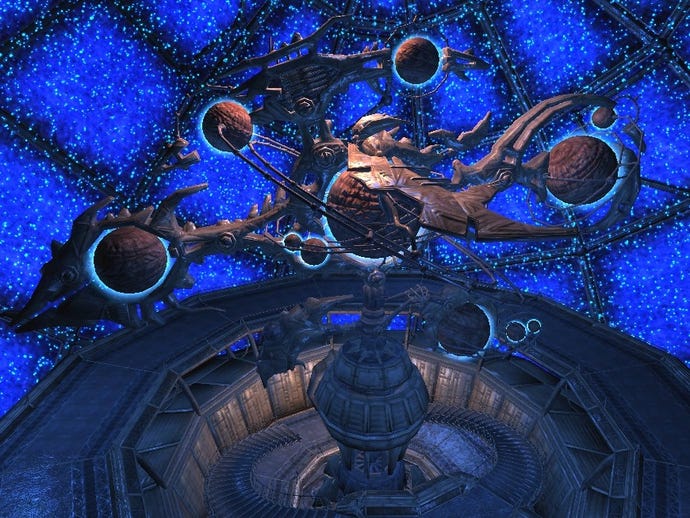
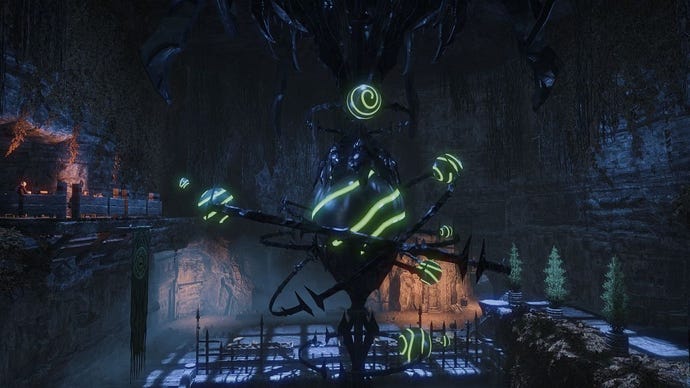
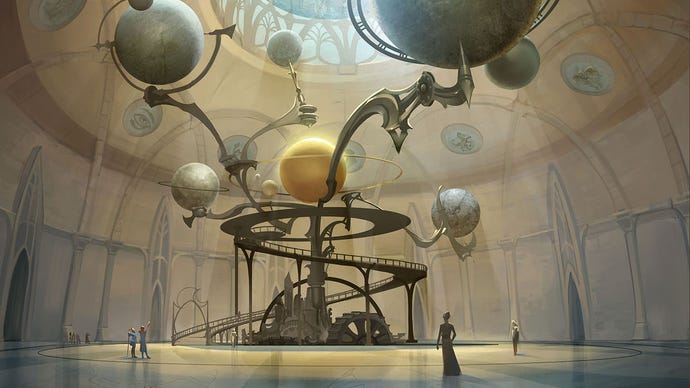
There's a nice frission between the stranger cosmological models in Elder Scrolls and the elements that seem based on normie outer space. There are gobbets of lore and locations that loosely reinterpret real-world missions to Earth's orbit and beyond. Take Elder Scrolls: Battlespire, a poorly-regarded dungeon crawler set on a kind of fantasy International Space Station, dedicated to the training of wizards. It's parked in a "slipstream realm" between various planes of Oblivion, which calls to mind the concept of a Lagrangian point.
There are even Elder Scrolls astronauts, of a sort. Consider the Sun Birds of Alinor, a group of Aldmeri explorers who supposedly sailed to Aetherius on ships of crystal and frozen sunlight. Modders have attempted to fill in the picture: one of the more ambitious Skyrim mods is Aethernautics from trainwiz, developer of the very Elder Scrollsy space sim Underspace and the accursed originator of Thomas the Tank Engines in Skyrim. This sizeable unoffical add-on sees you journeying to other plane(t)s in an "aethership" of Dwemer construction.
To orbit belatedly back to the "do Starfield's planets have invisible walls" controversy, Bethesda's head of publishing Pete Hines had this to say when asked whether you can explore whole planets after landing on them: "Yup, if you want. Walk on, brave explorer." Which seems at first to clarify the situation, but remains open to interpretation - so are there map boundaries or aren't there, Pete? - and I sort of prefer things that way.
While Starfield appears to be taking a relatively cut-and-dried, this-means-that approach with its worldbuilding, I'd love the game to channel some of the speculative energy and ambiguity that makes Morrowind, in particular, such a thrill to return to. Perhaps it could come about as part of storylines involving its three in-game religions, or in the course of hunting Artefacts as part of the main questline. It might address one of the more substantial complaints directed at Starfield, ahead of review – its numbing emphasis on scale for its own sake. What better antidote to such dreary AAA-game maximalist thinking than a healthy dollop of mystery?
